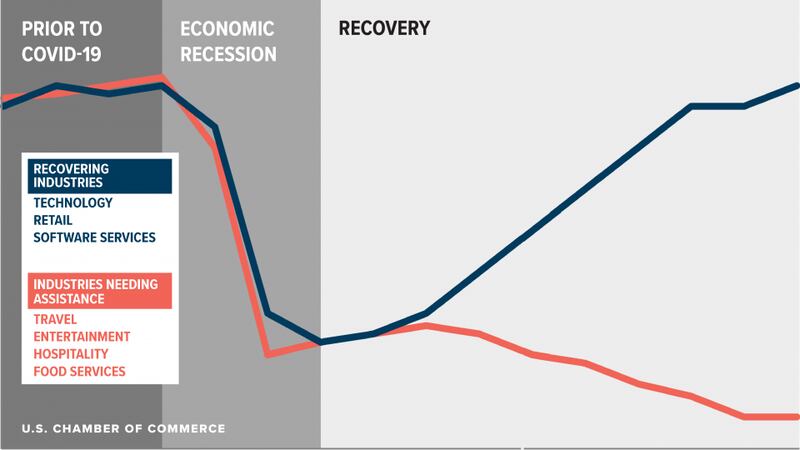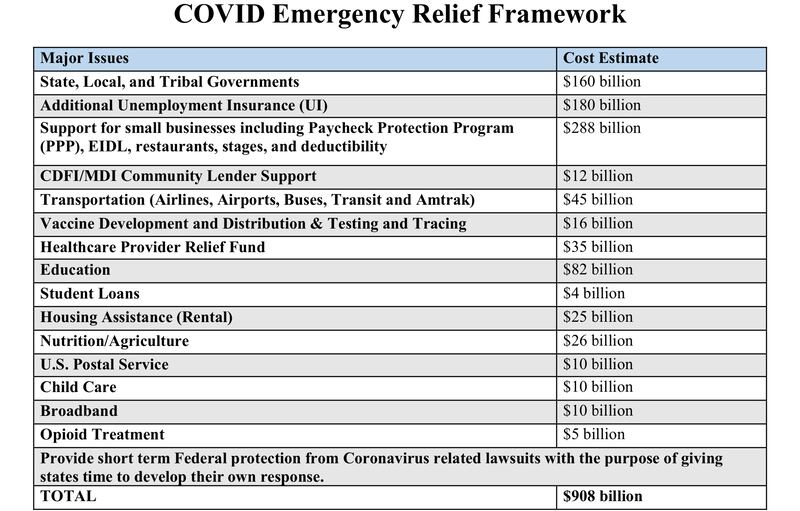Sen. Mitt Romney doesn’t expect to spend Christmas in Washington, D.C., wrapping a coronavirus relief package.
The Utah Republican expressed confidence that Congress can put a bow on more economic aid for pandemic-stricken Americans before adjourning for the holidays. Romney and three other GOP senators pitched their bipartisan $908 billion plan to Senate Majority Leader Mitch McConnell, R-Ky., on Thursday.
“I think he realizes that what we agreed to either in whole or in part has to be in place before we go home for the holidays,” Romney told the Deseret News Friday. “I think it would send a terrible message if we’re home celebrating Christmas and people’s unemployment has run out and businesses are being closed.”
McConnell has sought a $500 billion targeted relief bill, putting him at odds with House Speaker Nancy Pelosi, D-Calif., who pushed for an all-or-nothing $2.2 trillion proposal. The two top leaders spoke on the telephone Thursday about the legislation for the first time since the election.
Romney said McConnell recognized the “good news” that Pelosi has moved away from that and sees the compromise framework as a basis for negotiation.
On Friday, Pelosi told reporters at her weekly press conference that there is “momentum” to deliver an aid package before the lame-duck session of Congress adjourns.
“The tone of our conversation is one that is indicative of a decision to get the job done,” she said.
Pelosi and McConnell hope to attach a new coronavirus aid package to an omnibus spending bill to keep federal government agencies funded after Dec. 11, the day funding is set to expire.
Romney called the $908 billion proposal “huge progress” forged by Republicans and Democrats in the Senate and House and led by Sen. Joe Manchin, D-W.V., and that McConnell was complimentary of the effort. Support for the plan is growing in both parties, and pressure is mounting on congressional leaders to act.
“Ultimately, the leadership will have to decide do they want the entire bill that we have fashioned or do they want to take major parts of it and leave the more thorny parts to another date,” he said.
Liability protection from coronavirus-related lawsuits and the amount of money going to state and local governments are the major sticking points. Lawmakers generally agree on extending unemployment benefits, providing small-business grants and funding for vaccine distribution.
It is unclear where President Donald Trump stands on a relief plan. He told reporters Thursday that he would sign the bipartisan bill, but the White House later clarified he was talking about the smaller McConnell measure.
The bipartisan proposal does not include direct payments to Americans as did the massive stimulus legislation Congress passed in March.
A group of 125 economists sent a letter to Congress last month calling for more cash payments to American families to help them weather the pandemic. They argued direct checks are one of the quickest, most equitable and most effective ways to get families and the economy back on track.
Romney, who championed the stimulus checks, said that was needed when the country was on the verge of a pandemic and people had drained their back accounts on food and supplies. At this stage, he said, much of the country is back to work and doesn’t need a check when they’re employed.
“The economy is showing good signs of life, so we’re not looking for a stimulus. We’re looking to help people in need,” he said, listing the unemployed, small business and rural hospitals as those most in need.
“We want to make sure people who are having a hard time paying their rent are able to pay their rent and the landlords get paid,” Romney said. “We don’t want to have landlords kicking people out of their apartments.”
The lack of a direct cash payments is among the reasons Sen. Bernie Sanders, I-Vt., said Friday he can’t get behind the “Manchin-Romney COVID proposal unless it is significantly improved.” He also opposes legal immunity for companies, saying it would encourage them to avoid commonsense safety standards needed to protect workers and consumers.
“The American people need help and they need help now,” Sander said in a statement. “In my view, we have got to make sure that every working class American receives at least $1,200 in direct payments and that we do not provide a liability shield to corporations who break the law.”
A relief bill will help the Utah and national economies bridge the gap until vaccinations provide relief from the pandemic, said Natalie Gochnour, associate dean of David Eccles School of Business at the University of Utah and director of the Kem C. Gardner Policy Institute.
“The best policy advice is to target the stimulus to those businesses and individuals with greatest need so we minimize the long-term damage to businesses and households,” she said.
Even with a nation-leading economic performance and the financial stimulus already provided by the federal government, the Utah economy is still 8,400 jobs down from a year ago, with 67,200 Utahns currently unemployed, she said
Economists see about a one-month lag between higher COVID-19 case counts and unemployment.
“High case counts like we have today in Utah and the nation are a drag to economic activity. This is another reason why a stimulus will help,” Gochnour said.
The data continues to show that the impact of the pandemic is uneven by geography, industry, income level and occupation, creating what appears to be a “K-shaped” recovery, she said. A portion of the population and businesses recover quickly and completely, while others continue to struggle.

Despite public health professionals’ bleak outlook for the next three months, Gochnour said there is light at the end of the tunnel.
“If we stand steadfast and follow public health guidelines for a few more months, the economy will start to shine again,” she said.
People will start to travel, eat out and recreate. Businesses will start to rebuild their inventories again and consumer confidence will rise and spending will ensue, Gochnour said.
“The combination of stimulus, pent up demand, consumer confidence and inventory rebuilding will ensure that the economy recovers what was lost in the pandemic by the third quarter of next year,” she said.
Adding to the national debt remains Romney’s biggest concern with another pandemic relief measure. The bipartisan plan combines $560 billion in previously appropriated aid and $384 billion in new money.
“We have to be able to tackle that. I’m hoping that the Biden administration will pay attention to that. Clearly, the last administration did not,” he said.
Romney said government aid should not be expected every time there is a hiccup in the economy.
“But this is far more than a hiccup. This is a pandemic, and it’s a once-in-lifetime experience for most of us,” he said. “This is the kind of time when you feel it is appropriate to borrow.”



